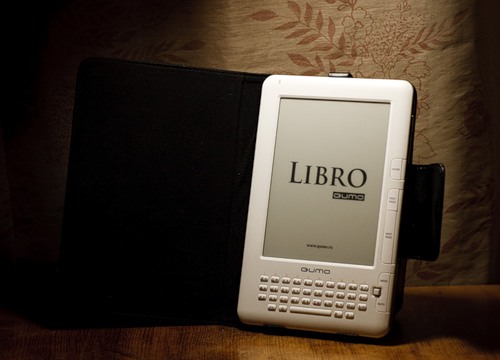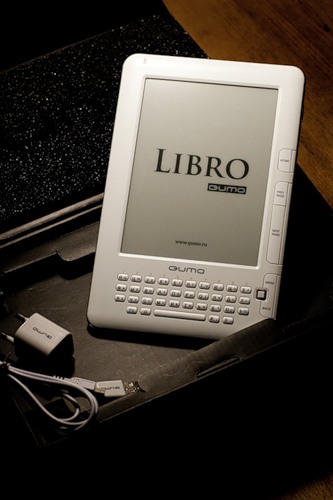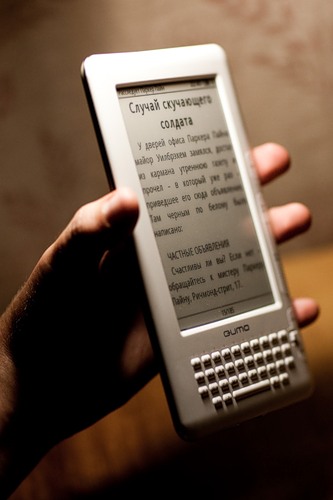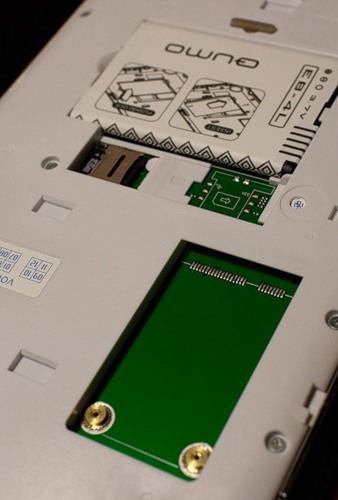QUMO Libro e-book - 10 days of use
For a long time I went around and around e-books, but somehow I did not dare to get myself any - the price did not suit me, the lack of confidence that I would use this type of device. However (quite by accident) I came across in the store on the device of the company QUMO - the e-book Libro. The combination looked quite tempting - a 6 "screen at a price of less than $ 300 (and lower than that of competitive devices from PocketBook or Sony). After a little reading and studying the TTX, it was decided to purchase the device. Yes, I know that there is no SDK for it, like for PocketBooks, and installation and development of additional software is currently not possible. Maybe something will change in the future,

When you take Libro into your hands, you don’t feel like giving it back - a thin and neat case, a beautiful metal back cover and a very decent build quality. The first impression is completed by a good, solid package in the form of a black box with magnetic locks and a layer of foam inside, on which the logo of the manufacturer is cut. The delivery set is standard - the device itself, a charger with a USB connector, the USB cable itself, a cover with a magnetic lock, a 2 Gb memory card (the device supports cards up to 32 Gb in size), headphones and various paper documents.

Partly because of the shape, partly because of the white color, but the charger and cable reminded me of the products of one fruit company for some reason. The cover smells of leather and fixes the device well enough, but at the same time you can get a book very quickly due to the method of mounting on brackets. I was quite pleased with the purchased device, and it was postponed until the next day - until the day of departure to rest.

Having delivered the book the next day, I copied my small library onto the memory card and decided to try Libro in action. Literally after a few pages, I noticed something was wrong - on the third or fourth click of the Next Page button, double page turning occurred. I began to check on other books, other formats - the effect was repeated. The most annoying thing in this situation was that there was about five hours left before the train and there was catastrophically little time to fight with the device just bought. With the help of search engines, forums and the official QUMO website, the device was flashed twice - first with firmware from 05/17/2010, and only then with the latest from 06/22/2010. Twice because the latest firmware initially did not want to be installed. Having killed everything for about an hour, I still went on vacation with a calm soul - the device worked, pages flipped as needed. However, this glitch did not completely disappear - it is very rare to this day, but the gravitational sensor has earned, and there have been some improvements in the menu.
Having read on the Internet and having listened to sellers about the modularity and extensibility of Libro, I was a little upset with what I saw under the hood. Yes, there is a place for both the Wi-Fi module and the 3G-SIM card, but this is bad - the connectors are not wired.

The device creates three directories on the memory card - Documents for books, Music for audio files and Pictures for images. Further, on the device’s desktop there are shortcuts for quick access to these directories. However, there is also a simple explorer for navigating the directories of a memory card with support for searching by name.
The most important thing in devices of this type - of course, is the screen, and since it is almost the same for everyone, I will not focus on it, but I will say the following with any other type of screens and devices (monitors, phones, tablets and PDA) I can’t comfortably read for three to four hours. Here I am 100% satisfied, but this is not the merit of Libro. And yet - in direct sunlight, the screen starts to behave in a strange way - artifacts appear in dark areas.
The device has 4 pre-installed fonts - Droid Sans Fallback, FreeSans, FreeMono and FreeSerif. The first font looks best (it’s also by default), but with one strange problem - it doesn’t have some characters, for example, quotation marks-fir-trees — squares with the symbol code appear instead. The last font, as the name implies, is serif, but the rendering quality does not allow me to use it. FreeSans normally displays all characters, and is acceptable for rendering. For fonts, I would put a triple, because for a reader, this is a very important parameter, and the manufacturer could provide a mechanism that allows the user to set their own fonts.
I mainly read books in fb2 format, so most of the described will be related to this format, although a pdf device understands and it is quite possible to read it, but, in my opinion, it’s still not very convenient. So, the most important minus is that it is impossible to use a table of contents, such functionality is simply not implemented. You cannot follow footnotes and links. In fact, only text and illustrations remained from fb2. Yes, we remember the position in the text, you can do a search, set bookmarks (which a full keyboard helps a lot), keep a list of the latest books for quick access. Another very convenient feature is the navigation joystick changes the font size on the fly, which is very convenient when several people with different vision use the device at the same time. RTF is normally displayed and read - no problem. I still can’t understand the logic of the page counter at the bottom of the screen - it changes to unity only for the second or third page turning - i.e. you can roughly estimate the position in the text, but you can’t go directly to any page. Most likely, the number of pages is calculated somewhere inside and does not depend on the font size.

It can be very nice to complement reading by listening to various musical compositions. Libro has on board an audio player (with ogg support, by the way) and an FM radio (only with headphones), a headphone jack and even two speakers. Playback quality, volume are quite acceptable, there are various modes (with repeat, without repeat), search for tracks. The FM radio is pretty weak - I got a good reception in less than half the cases, so you shouldn’t rely on the tuner much. And now another minus is the background work of the player. It is, only here, unlike the instructions, I still could not find a menu item “show player” in any menu. Those. music plays, but to turn it off, go back to the directory with audio, select a track, and when the player window appears, turn it off. I attribute the firmware glitch, but a serious flaw. Yes,
In general, the device justified its purchase - over 10 days of vacation about 10 medium-sized books were read by me, my wife and child, and such sharing was quite convenient thanks to the history functions and quick font change. Well, I won’t even talk about the difference in weight, which is quite important for the holiday season. But I would like to note that the software filling of the device is still very weak, little functional and contains errors. In my opinion, the opening of the firmware (as for PocketBook) or at least the release of the SDK could solve a lot of problems and increase the attractiveness of the device for consumers, especially since everything is very good with the hardware and appearance.

First impressions and packaging
When you take Libro into your hands, you don’t feel like giving it back - a thin and neat case, a beautiful metal back cover and a very decent build quality. The first impression is completed by a good, solid package in the form of a black box with magnetic locks and a layer of foam inside, on which the logo of the manufacturer is cut. The delivery set is standard - the device itself, a charger with a USB connector, the USB cable itself, a cover with a magnetic lock, a 2 Gb memory card (the device supports cards up to 32 Gb in size), headphones and various paper documents.

Partly because of the shape, partly because of the white color, but the charger and cable reminded me of the products of one fruit company for some reason. The cover smells of leather and fixes the device well enough, but at the same time you can get a book very quickly due to the method of mounting on brackets. I was quite pleased with the purchased device, and it was postponed until the next day - until the day of departure to rest.

Flashing
Having delivered the book the next day, I copied my small library onto the memory card and decided to try Libro in action. Literally after a few pages, I noticed something was wrong - on the third or fourth click of the Next Page button, double page turning occurred. I began to check on other books, other formats - the effect was repeated. The most annoying thing in this situation was that there was about five hours left before the train and there was catastrophically little time to fight with the device just bought. With the help of search engines, forums and the official QUMO website, the device was flashed twice - first with firmware from 05/17/2010, and only then with the latest from 06/22/2010. Twice because the latest firmware initially did not want to be installed. Having killed everything for about an hour, I still went on vacation with a calm soul - the device worked, pages flipped as needed. However, this glitch did not completely disappear - it is very rare to this day, but the gravitational sensor has earned, and there have been some improvements in the menu.
Expansion and modularity
Having read on the Internet and having listened to sellers about the modularity and extensibility of Libro, I was a little upset with what I saw under the hood. Yes, there is a place for both the Wi-Fi module and the 3G-SIM card, but this is bad - the connectors are not wired.

Using
The device creates three directories on the memory card - Documents for books, Music for audio files and Pictures for images. Further, on the device’s desktop there are shortcuts for quick access to these directories. However, there is also a simple explorer for navigating the directories of a memory card with support for searching by name.
The most important thing in devices of this type - of course, is the screen, and since it is almost the same for everyone, I will not focus on it, but I will say the following with any other type of screens and devices (monitors, phones, tablets and PDA) I can’t comfortably read for three to four hours. Here I am 100% satisfied, but this is not the merit of Libro. And yet - in direct sunlight, the screen starts to behave in a strange way - artifacts appear in dark areas.
The device has 4 pre-installed fonts - Droid Sans Fallback, FreeSans, FreeMono and FreeSerif. The first font looks best (it’s also by default), but with one strange problem - it doesn’t have some characters, for example, quotation marks-fir-trees — squares with the symbol code appear instead. The last font, as the name implies, is serif, but the rendering quality does not allow me to use it. FreeSans normally displays all characters, and is acceptable for rendering. For fonts, I would put a triple, because for a reader, this is a very important parameter, and the manufacturer could provide a mechanism that allows the user to set their own fonts.
I mainly read books in fb2 format, so most of the described will be related to this format, although a pdf device understands and it is quite possible to read it, but, in my opinion, it’s still not very convenient. So, the most important minus is that it is impossible to use a table of contents, such functionality is simply not implemented. You cannot follow footnotes and links. In fact, only text and illustrations remained from fb2. Yes, we remember the position in the text, you can do a search, set bookmarks (which a full keyboard helps a lot), keep a list of the latest books for quick access. Another very convenient feature is the navigation joystick changes the font size on the fly, which is very convenient when several people with different vision use the device at the same time. RTF is normally displayed and read - no problem. I still can’t understand the logic of the page counter at the bottom of the screen - it changes to unity only for the second or third page turning - i.e. you can roughly estimate the position in the text, but you can’t go directly to any page. Most likely, the number of pages is calculated somewhere inside and does not depend on the font size.

It can be very nice to complement reading by listening to various musical compositions. Libro has on board an audio player (with ogg support, by the way) and an FM radio (only with headphones), a headphone jack and even two speakers. Playback quality, volume are quite acceptable, there are various modes (with repeat, without repeat), search for tracks. The FM radio is pretty weak - I got a good reception in less than half the cases, so you shouldn’t rely on the tuner much. And now another minus is the background work of the player. It is, only here, unlike the instructions, I still could not find a menu item “show player” in any menu. Those. music plays, but to turn it off, go back to the directory with audio, select a track, and when the player window appears, turn it off. I attribute the firmware glitch, but a serious flaw. Yes,
Total
In general, the device justified its purchase - over 10 days of vacation about 10 medium-sized books were read by me, my wife and child, and such sharing was quite convenient thanks to the history functions and quick font change. Well, I won’t even talk about the difference in weight, which is quite important for the holiday season. But I would like to note that the software filling of the device is still very weak, little functional and contains errors. In my opinion, the opening of the firmware (as for PocketBook) or at least the release of the SDK could solve a lot of problems and increase the attractiveness of the device for consumers, especially since everything is very good with the hardware and appearance.
